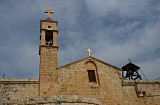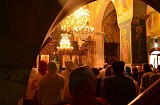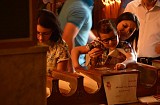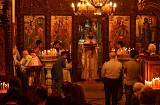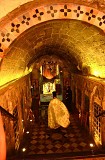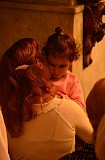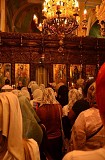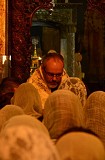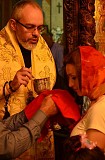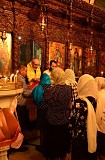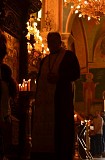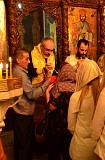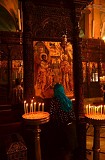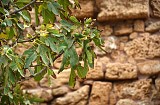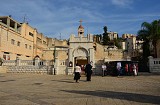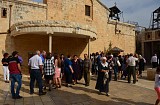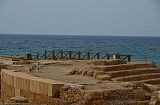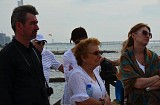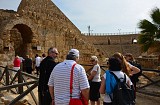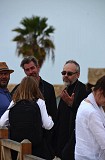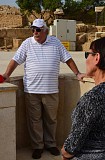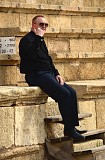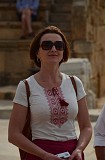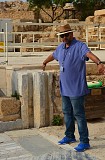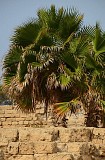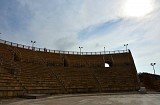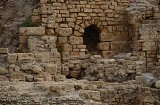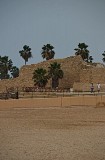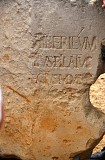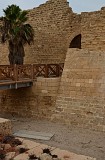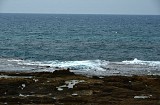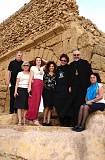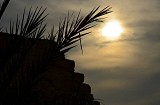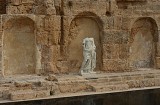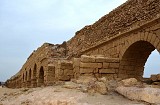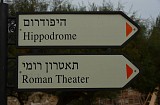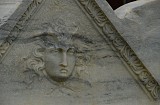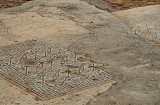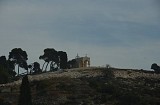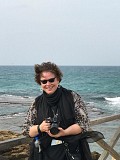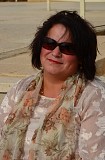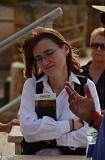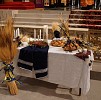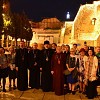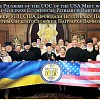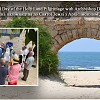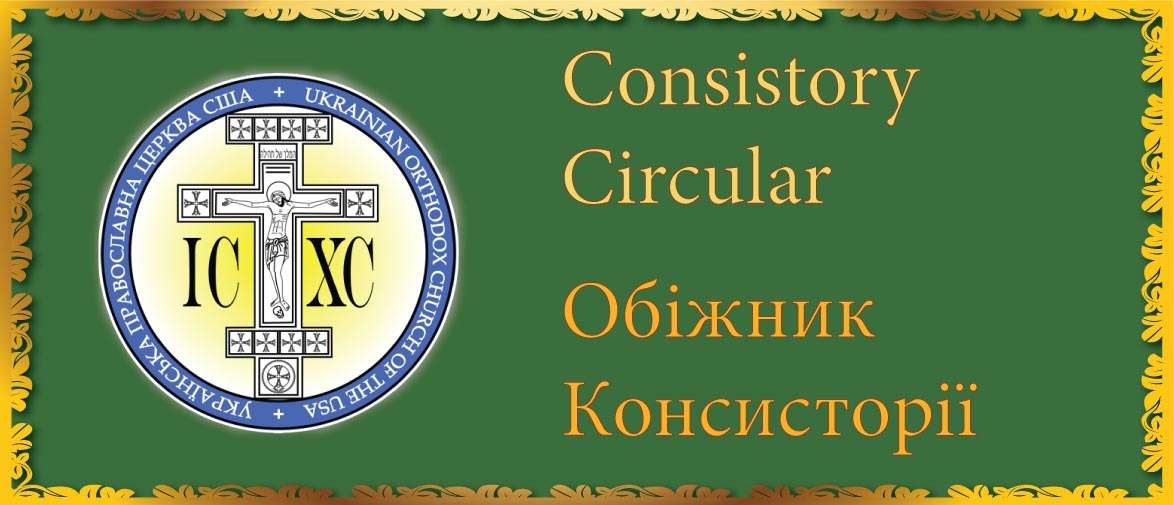Pilgrims of the Ukrainian Orthodox Church of the USA Fulfill the 4th day of Their Pilgrimage to Holy Land
Четвертий день паломництва паломників Української Православної Церкви УПЦ США на Святу Землю
Reflection and Photos by Elizabeth Symonenko, Consistory Secretary
Sundays are always great, however, experiencing the Lord’s Day in the Holy Land was such a moving experience. Having checked out of the hotel early in the morning, the pilgrims of the UOCofUSA returned once again to the Orthodox Church of the Annunciation. We arrived just as Matins was concluding, and while the clergy headed in to the Altar, the laity mingled with the locals, lighting candles, praying before icons, or simple trying to absorb everything around them.
The Liturgy was mainly in Arabic, with a little Greek peppered throughout. It is a rare thing for a Ukrainian contingency, from America, to attend a Liturgy where the only thing they understand is the Greek “Kyrie Eleison”. However, even though we didn’t understand most of the words we were hearing, nonetheless, our souls knew exactly what was being said. We joined Ukrainian to the Arabic in all our prayers, mingling our voices with all the others which echoed off the tall vaulted ceilings.
Used to rigid order back at my own home parish, I was amazed at how this parish seemed to be almost alive with motion. As the Liturgy began, the church began to fill as people slowly filtered in. The faithful stood, sat or moved around. People were constantly coming and going. There were people entering the side door, while others were venerating icons on the iconostas, and others were lighting candles, or making their way down to the spring. There was so much movement, that the congregation seemed like a living organ, and yet none of it was disruptive. Your eye didn’t catch the boy on the far right as he squirmed, because everything was defined by movement.
Many of us, asked to confess our sins, and having done so, found ourselves down the stairs and standing next to the spring from where the Virgin Mary was drawing water when the Archangel Gabriel visited her. We remained in the lower portion, by the spring, listening as the gurgling water joined its voice to the voices of the faithful as they sang.
We got in line behind the others who were approaching, again, not a single file line, just a crowd of people shuffling forward, quietly and peacefully. Standing in that crowd, we were amazed by the iconography covering every wall, and we were even more amazed when we glanced up and His Eminence Archbishop Daniel emerged holding the chalice.
How often does one get to be cleansed of sin in the very spot where the Lord Incarnated? This was the place where it all actually began, and we, found ourselves overwhelmed with emotion. Being in this holy place, repenting, confessing, getting absolution and now being fortified and cleansed by the Holy Eucharist left us all struggling to breathe, for it was such an overwhelmingly humble experience, filled with God’s love for all of us.
With tears shining in our eyes, we emerged outside in to the sunshine, but, even the sun couldn’t outdo the light that emanated from our souls this day. Each one of us was so affected by this experience, that we made our way back to the waiting bus quietly, and yet with smiles on our faces, feeling cleansed and as if a heavy burden had been lifted from us.
The distance from Nazarath to Jerusalem is approximately 164 kilometers. We traveled along curving wide roads, once again passing the hills of Megiddo, with its tall stand of palms swaying in the breeze. Along the sides of the road were huge stands of Eucalyptus which had originally been purposefully imported from Australia in order to be planted in the swamp land to reduce the amount of water in the soil. While the tree failed to successfully transform the environment, it did slowly spread and now is found throughout the country.
On our left we passed the Prison of Megiddo, which is mainly utilized for Palestinian prisoners. When Israeli authorities wanted to expand the Megiddo Prison, they tapped their captive labor pool and put dozens of inmates to work digging inside the compound. As is common practice in Israel, the site underwent a check for possible archaeological ruins before heavy equipment could be moved in, and in doing so they discovered a Christian religious site that dates to the third century A.D. and could be the earliest Christian church unearthed in the Holy Land, and possibly one of the earliest in the world. In addition to beautiful fish mosaics (the original symbol of Christianity), a number of inlaid inscriptions were found in the tile. The discovery of a 3rd century Christian church at Megiddo, along with an inscription to the "God Jesus Christ" confirms that Christians worshipped Jesus Christ as God before the council of Nicaea.
To our right we watched history fly by. The town near the place where Jesus exorcized the 100 demons from Legion, which then went in to a swine herd and jumped off a cliff to their deaths.
Before we knew it we had arrived in Caesarea, and got our first glimpse of the Mediterranean Sea. Caesarea Maritima was one of the most important cities in the Roman World, the Roman capital of the province of Judea at the time of Jesus, and a Crusader fortress along the road from Acre to Jerusalem. Today, Caesarea is a large and interesting national park filled with historic ruins, curving paths, shops and cafes. The major points of attraction are the Roman Theater, the Hippodrome, Herod’s seaside palace, and the ruins of the port.
The Roman Theater seats 3, 500 individuals. Below the seats is an empty area which was able to be closed off and filled with water for maritime battle scenes. The marble stage had little nooks carved into it where would have stood statues of dieties. Historically, only men were permitted to be actors. To depict women the men would wear dresses, and masks. The fact that they wore masks and therefore had varying personalities gave birth to the term hypocrite.
Further down the path we come to Herod’s seaside palace, where was discovered an archaeological find with an inscription mentioning the name "Pontius Pilatus"; a double aqueduct that brought water from springs at the foot of Mount Carmel; a boundary wall; and a wide moat protecting the harbor to the south and west. The harbor was the largest on the eastern Mediterranean coast.
Leaving behind the Palace, which contained the ruins of the room in which St. Paul was detained, we walked the length of the Hippodrome which had hosted many gladiator games. In Byzantine times the games were suspended, however, the structure continued to be used for horse and chariot races. On the far end we came to the Crusaders Fortress, with its angled walls which allowed the defenders to easily see the enemy below them.
History was all around us, and below us. As we walked with stepped on various pebbles, shells and red clay bits. His Eminence gathered a few of the clay pieces and distributed them to us, as Khalil, our guide, informed us that these bits have washed up by the ocean waves of the portions of the city buried under water, and that these would be pieces of clay pots dating back 2,000 years.
With so much history rolling around in our heads, we stopped at the local café for a bit of a rest and to continue our lesson. Over cappuccinos, espressos and fresh squeezed orange juice we spent a leisurely hour enjoying each other’s company.
As we left our final stop of the day which was the Roman Aqueduct, which brought water throughout the ancient empire, we traveled towards Jerusalem, passing Tel Aviv.
This night’s Super Moon lit up the landscape and made everything appear surreal, and even though we were tired, we couldn’t keep our eyes off the landscape, watching history, present day life, and the future unfold before us. We finally arrived at the Olive Tree hotel for a scrumptious dinner and some rest before embarking on our next day’s adventures.
Day 4 - Pilgrimage to Holy Land 2016 - 11/15/2016
Photos by Elizabeth Symonenko
(62 images)
|
| |||||||||||||
